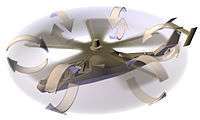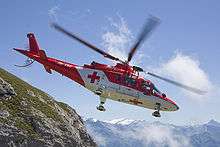Vortex ring state
The vortex ring state, also known as settling with power, is a dangerous condition that may arise in helicopter flight, when a vortex ring system engulfs the rotor causing severe loss of lift. The FAA sees these terms as synonymous, whereas Transport Canada sees them as two different phenomena.[1]
Essentially, the helicopter descends into its own downwash. When the condition arises, increasing the rotor power merely feeds the vortex motion without generating additional lift.[2][3]
This condition also occurs with tiltrotors, and was responsible for an accident involving a V-22 Osprey. Vortex ring state caused the loss of a heavily modified MH-60 helicopter during Operation Neptune Spear, the 2011 raid that killed Osama bin Laden.[4]
Description

In forward flight, there is no upward flow (upflow) of air in the hub area. As forward airspeed decreases and vertical descent rates increase, an upflow begins because there are no airfoil surfaces in the mast and blade grip area. As volume of upflow increases, the induced flow (air pulled or "induced" down through the rotor system) of the inner blade sections is overcome and the blades begin to stall near the hub. As the inner blade sections stall, a second set of vortices, similar to the rotor tip vortices, form in the center of the rotor system. The inner set of vortices decreases the amount of lift being produced and causes an increase in sink rate. In an accelerated condition, the inner and outer vortices begin to feed each other to the point where any increase in rotor blade pitch angle increases the interaction between the vortices and increases the rate of descent. In this state, the helicopter is operating in its own downwash, descending through descending air. The failure of a helicopter pilot to recognize and react to the condition can lead to high descent rates and impact with terrain.
Occurrence
A helicopter normally encounters this condition when attempting to hover out of ground effect above the hovering ceiling for the aircraft, hovering out of ground effect without maintaining precise altitude control, and while making downwind or steep, powered approaches when the airspeed drops to nearly zero.
Detection and correction
The signs of settling with power are a vibration in the main rotor system[5] followed by an increasing sink rate and possibly a decrease of cyclic authority.[3]
In single rotor helicopters, the vortex ring state can be corrected by moving the cyclic control in any direction, so as to get out of the column of air created by the rotor downwash, which controls the pitch angle of the rotor blade, slightly pitching nose down, and establishing forward flight. In tandem-rotor helicopters, recovery is accomplished through lateral cyclic or pedal input. The aircraft will fly into "clean air", and will be able to regain lift.
Another correction, the Vuichard Recovery Technique, was developed by Claude Vuichard, a Federal Office for Civil Aviation (FOCA) inspector in Switzerland. It resembles the lateral recovery technique for tandem rotor helicopters but with the assistance of tail rotor thrust: apply cyclic in the direction of tail rotor thrust, and increase the collective to climb power, coordinated with the power pedal to maintain heading (cross controls). Recovery is complete when the rotor disc reaches the upwind part of the vortex. Average loss of altitude during the recovery is 20–50 ft depending on the duration of the recovery procedure.[6][7]
Powering out of vortex ring state
It is possible to power out of vortex ring state, but this requires having about twice the power it takes to hover. Only one full-scale helicopter, the Sikorsky S-64 Skycrane, is able to do this, when unladen.[8]
Pilot or operator reaction
Helicopter pilots are most commonly taught to avoid settling with power by monitoring their rates of descent at lower airspeeds. When encountering settling with power, pilots are taught to apply forward cyclic to fly out of the condition or lowering collective pitch.[3] While transitioning to forward or lateral flight will alleviate the condition by itself, lowering the collective to reduce the power demand decreases the size of the vortices and reduces the amount of time required to be free of the condition. However, since the condition often occurs near the ground, lowering the collective may not be an option; a loss of altitude will occur proportional to the rate of descent developed before beginning the recovery. In some cases, vortex ring state is encountered and allowed to advance to the point that the pilot may lose cyclic authority due to the disrupted airflow. In these cases, the pilot's only recourse may be to enter an autorotation to break the rotor system free of its vortex ring state.
Tandem rotor helicopters
In a tandem rotor helicopter, forward cyclic will not arrest the rate of descent caused by settling with power. In such a helicopter, which utilizes differential collective pitch in order to gain airspeed, lateral cyclic inputs must be made accompanied by pedal inputs in order to slide horizontally out of the vortex ring state's disturbed air.
Radio control quadcopters
Small quadcopters are subject to normal rotorcraft aerodynamics, including vortex ring state.[9]
See also
References
- ↑ "Helicopter Flight Training Manual (TP 9982) - EXERCISE 26 - VORTEX RING" Transport Canada, 20 May 2010. Accessed: 13 September 2014. Quote: There are some uninformed pilots who use “settling with power” to describe vortex ring, in fact some publications use the terms interchangeably. Confusion results when symptoms are related that do not describe true vortex ring but rather describe “settling with insufficient power”.
- ↑ Main page. Chapter 11: Helicopter Emergencies and Hazards Rotorcraft Flying Handbook, FAA Manual H-8083-21. Complete manual, 84 MB, Washington, DC: Flight Standards Service, Federal Aviation Administration, U.S. Dept. of Transportation, 2001. ISBN 1-56027-404-2, page 11-5.
- 1 2 3 Advisory Circular (AC) 61-13B, Basic Helicopter Handbook, U.S. Department of Transportation, Federal Aviation Administration. 1978
- ↑ Capaccio, Tony (May 5, 2011). "Helicopter Carrying SEALs Downed by Vortex, Not Mechanical Flaw or Gunfire". Bloomberg L.P.
- ↑ Johnson, Wayne. Helicopter theory pp99+106, Courier Dover Publications, 1980. Accessed: 25 February 2012. ISBN 0-486-68230-7
- ↑ Tucker, Tim. "Flying Through the Vortex". Rotor & Wing. Aviation Today. Retrieved 13 February 2016.
- ↑ Robinson R22/R44 Flight Training Guide, R22 Maneuver guide, Settling-With-Power/Vortex Ring State, Page 29, Revised: October 2013
- ↑ http://scs-europe.net/conf/ecms2007/ecms2007-cd/ecms2007/ecms2007%20pdf/ese_0121.pdf
- ↑ "Quadcopter "Wobble of Death": VRS Recovery and Avoidance". YouTube. Retrieved 21 September 2014.
External links
- Free-Vortex Wake Calculations of Helicopter Rotors and Tilt-Rotors Operating-In and Transitioning Through the Vortex Ring State
- Video of possible vortex ring helicopter crash
- Dispelling the Myth of the MV-22 Archive
- Vortex Ring on SKYbrary
